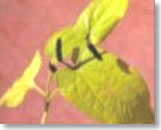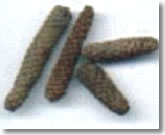
PIPPALI
Botanical Name: Piper longum ( PIPERACEAE)
English Name: Long pepper
Hindi Name: Pipala

Introduction: This is one of the most ancient herbs in vogue in traditional medicine. In Atharva veda, Pippali is mentioned as Rasayana (anti-oxidant). Hindu mythology reveals that Pippali has its origin during Samudra manthana along with Amrita (elixir). Both Charaka and Susruta have quoted this plant among the the degestives as well as health tonics. But is tis interesting to note that Charaka cautioned excessive usuage of this plant. There are two varieties of Pippali small & large which are botanically identified with P. longum and P.chaba. Its root is also used extensively in medicine.
Distribution: Found in the hotter parts of India from central Himalayas to Assam, Khasi and Mikir hills. Also found in forest of Western Ghats from Konkan to Kerala.
Chemical Constituents: Essential oil, piperene, piplartine, piperlongumine, piperlonguminine, pipernonaline, iperundecalidine, pipercide etc.
Parts Used: Fruits & root
Properties: acrid, stimulant, appetizer, aphrodisiac, anti-oxidant, anti-tussive etc.
Indications: Splenomegaly, fevers, arthritis, loss of appetite, skin conditions etc.
Dose: Fruit powder ½ -1g; root powder 1-2g.
Therapeutic Uses:
- Respiratory infections: Pippali+anola+dry ginger powder given along with sugar.
- Vomiting: Pippali powder+sugar+ honey.
Scientific Studies
Anti-tubercular activity: The pellitorine type of isobutylamide was reported to exhibit significant anti-tubercular activity in vitro and the effect is about 20% of the potency of streptomycin ( Report of ICMR, 1967-68).
Anti-spasmodic activity: Piperlongumine as well as the whole plant extract showed marked anti-spasmodic action on isolated tissues (Prasad & Chowdhury, 1967).
Anti-tussive activity: Crude extracts suppressed the ciliary movements of the oesophagus of frog ( Bhanga et al., 1964)
Anti-inflammatory activity: Market activity is established against carrageenin-induced rat paw edema ( Sharma & Singh, 1980).
Anthelmintic activity: The oil of P.longum fruit possessed anthelmintic activity ( D’cruz et al., 1980).
Cultivation Technology: Lateritic soils with good moisture holding capacity and rich in humus are best for its cultivation. It requires partial shade for its ideal growth. The plant can be easily propagated through suckers or vine cuttings. Field should be ploughed well and farm yard manure should be mixed in soil prior to planting. 10-15 cm long vine cuttings are planted in poly bags/ nursery beds. Rooted cuttings are transplanted at the spacing of 60-60 cm. Once the crop is set, it will be continued for 3-5 years.
Harvesting: Mature dried spikes are collected.







